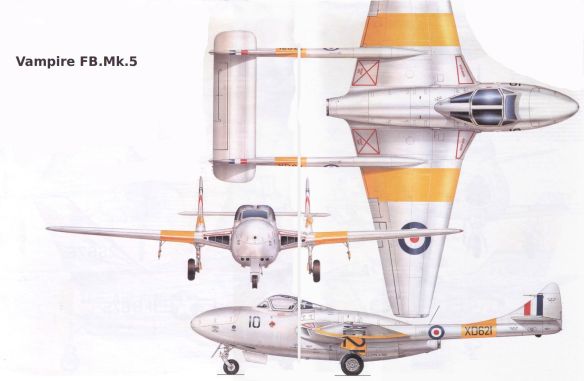The diminutive Vampire was England’s second jet fighter and spawned a large number of subtypes. It enjoyed a lengthy career and was exported to no less than 25 nations.
The British Air Ministry issued Specification E.6/41 in 1941 to obtain a jet fighter built around a single de Havilland Goblin centrifugal-flow turbojet. The relatively low thrust of this early engine virtually dictated the design because of the necessity to keep the tailpipe as short as possible. De Havilland responded with a unique twin-boomed approach. The fuselage was a bulbous pod housing the pilot, engine, nosewheel, and armament. The pilot sat in a cockpit close to the nose and under a bubble canopy that afforded excellent vision. The all-metal wing was mid-mounted and affixed by twin booms extending rearward, themselves joined by a single stabilizer. The prototype first flew in September 1943, with Geoffrey de Havilland Jr. at the controls. He reported excellent flight characteristics, even at breathtaking speeds of 500 miles per hour. In 1946 the aircraft entered the service as the DH 100 Vampire (the original designation was Spider Crab). Subsequent modifications yielded the Mk III, which had larger fuel tanks and a redesigned tail. However, it was not until 1949 that the major production version, the FB Mk 5, arrived. It featured clipped wings, longer undercarriage, and the ability to carry rockets and bombs.
The Vampire exhibited such docile handling in flight that it was an ideal trainer. It was also exported around the world and saw extensive service with 25 air forces. Switzerland operated its Vampires with little interruption until 1991. On December 3, 1945, a Royal Navy Sea Vampire also became the first pure jet to operate off a carrier deck. This version, naturally, was stressed for catapulting and used an arrester hook. One final model, the NF Mk 10, was a two-seat night fighter version with radar. The total number of Vampires manufactured was around 2,000. It was a classic early jet design.
Variants
* DH 100: three prototypes.
* Vampire Mk I: single-seat fighter version for the RAF; 244 production aircraft being built.
* Mk II: three prototypes, with Rolls-Royce Nene turbojet engine. One built and two conversions.
* F 3: single-seat fighter for the RAF. Two prototypes were converted from the Mk 1; 202 production aircraft were built, 20 were exported to Norway
* Mk IV: Nene-engined project, not built.
* FB 5: single-seat fighter-bomber version. Powered by the Goblin 2 turbojet; 930 built for the RAF and 88 for export.
* FB 6: single-seat fighter-bomber. Powered by a Goblin 3 turbojet; 178 built, 100 built in Switzerland for the Swiss Air Force.
* Mk 8: Ghost-engined, one conversion from Mk 1.
* FB 9: tropicalised fighter-bomber through addition of air conditioning to Mark 5. Powered by Goblin 3 turbojet; 326 built, mostly by de Havilland.
* Mk 10 or DH 113 Vampire: Goblin-powered two-seater prototype; two built.
* NF 10: two-seat night fighter version for the RAF; 95 built including 29 as the NF54.
* Sea Vampire Mk10: prototype for deck trials. One conversion.
* Mk 11 or DH 115 Vampire Trainer: private venture, two-seat jet trainer prototype.
* T 11: two-seat training version for the RAF. Powered by a Goblin 35 turbojet engine; 731 were built.
* Sea Vampire F 20: naval version of the FB 5; 18 built by English Electric.
* Sea Vampire Mk 21: six aircraft converted from F.3s with strengthened belly and arrester hook for trials of undercarriage-less landings on flexible decks.[23]
* Sea Vampire T 22: two-seat training version for the Royal Navy; 73 built by De Havilland.
* FB 25: FB 5 variants; 25 exported to New Zealand
* F 30: single-seat fighter-bomber version for the RAAF. Powered by Rolls-Royce Nene turbojet; 80 built in Australia.
* FB 31: Nene-engined, 29 built in Australia.
* F 32: one Australian conversion with air conditioning.
* T 33: two-seat training version. Powered by the Goblin turbojet; 36 were built in Australia.
* T 34: two-seat training version for the Royal Australian Navy; five were built in Australia.
* T 34A: Vampire T 34s fitted with ejector seats.
* T 35: modified two-seat training version; 68 built in Australia.
* T 35A: T33 conversions to T35 configuration.
* FB 50: exported to Sweden as the J 28B; 310 built, 12 of which were eventually rebuilt to T 55 standard.
* FB 51: export prototype (one conversion) to France.
* FB 52: export version of Mk 6, 101 built; 36 exported to Norway and in use from 1949 to 1957
* FB 52A: single-seat fighter-bomber for the Italian Air Force; 80 built in Italy. .
* FB 53: single-seat fighter-bomber for the Armee de l’Air; 250 built in France, as the Sud-Est SE 535 Mistral.
* NF 54: export version of Vampire NF 10 for the Italian Air Force; 29 being built.
* T 55: export version of the DH 115 trainer; 216 built and six converted from the T 11.
Specifications (Vampire FB6)
General characteristics
* Crew: 1
* Length: 30 ft 9 in (9.37 m)
* Wingspan: 38 ft (11.58 m)
* Height: 8 ft 10 in (2.69 m)
* Wing area: 262 ft² (24.34 m²)
* Empty weight: 7,283 lb (3,304 kg)
* Max takeoff weight: 12,390 lb [36][37] (5,620 kg)
* Powerplant: 1× de Havilland Goblin 3 centrifugal turbojet, 3,350 lbf (14.90 kN)
Performance
* Maximum speed: 548 mph (882 km/h)
* Range: 1,220 mi (1,960 km)
* Service ceiling: 42,800 ft (13,045 m)
* Rate of climb: 4,800 ft/min[37] (24.4 m/s)
Armament
* Guns: 4 × 20 mm (0.79 in) Hispano Mk.V cannons
* Rockets: 8 × 3-inch “60 lb” rockets
* Bombs: or 2 × 500 lb (225 kg) bombs or two drop-tanks
